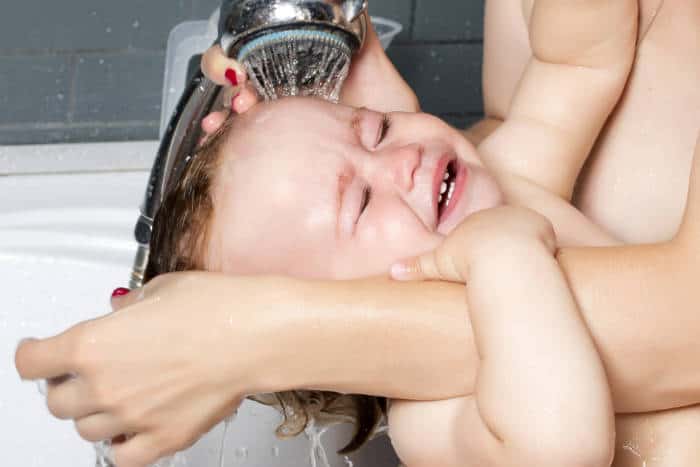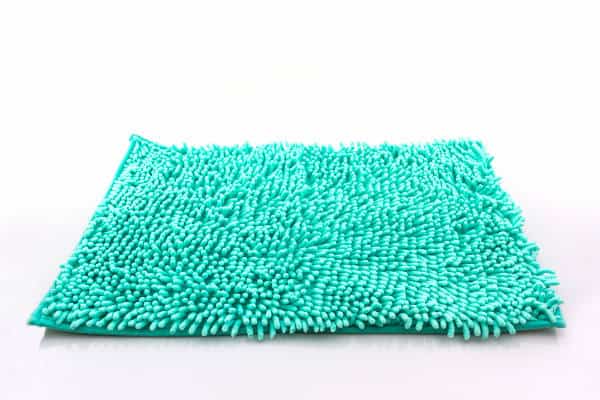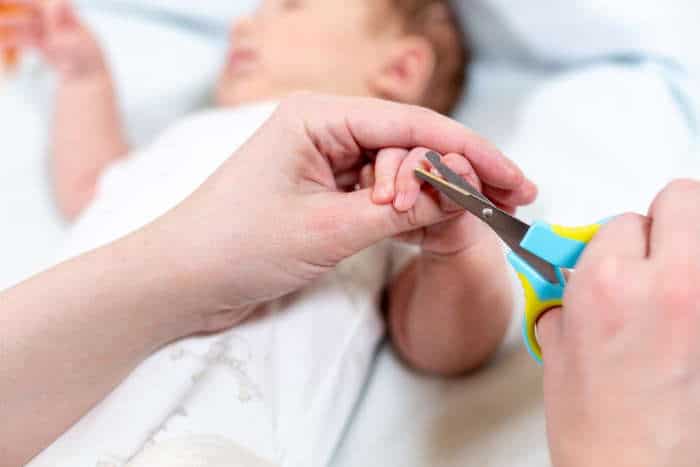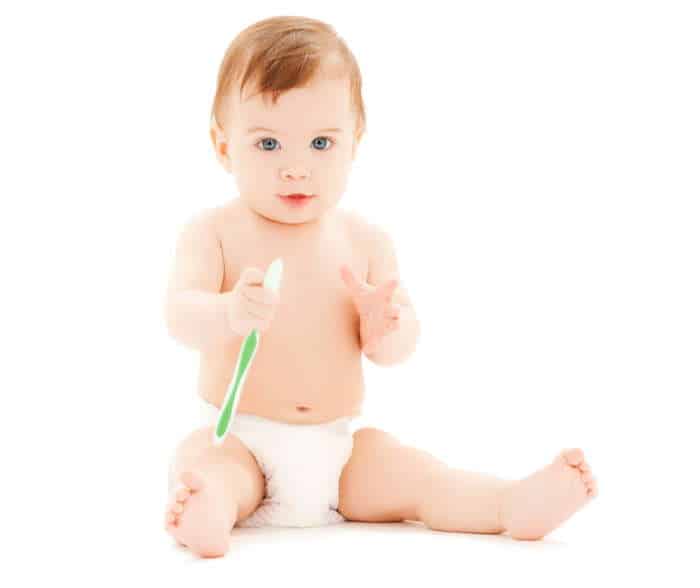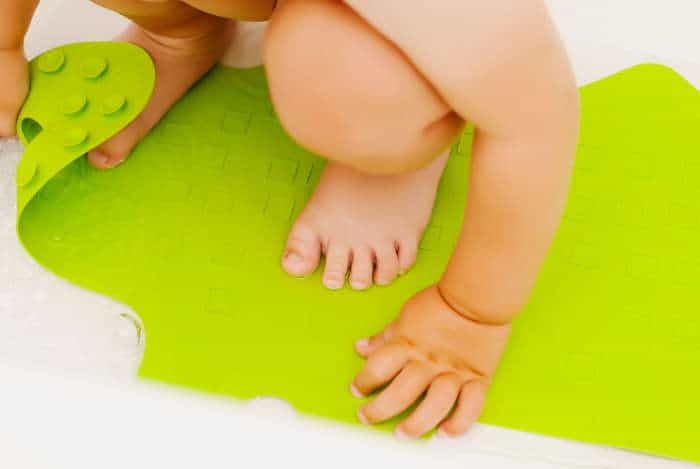Baby bath time… Looks easy on T.V. right? Your baby is cooing and splashing in the bubbles. As a new parent, however, there’s a treasure trove of information you probably haven’t given a second thought to until it’s your baby in the water.
How long should I wash? Can I wash that? What baby bubble bath is safe?
It’s more complicated than dipping them in a tub of water and calling it a day. Then, throw in the added nerves of being a brand new parent and you’re bound to feel uneasy about the new parts of your daily routine.
No one wants to mess up or put their baby in danger. So, we’ve put together a helpful guide that covers the most pressing concerns when bathing your baby
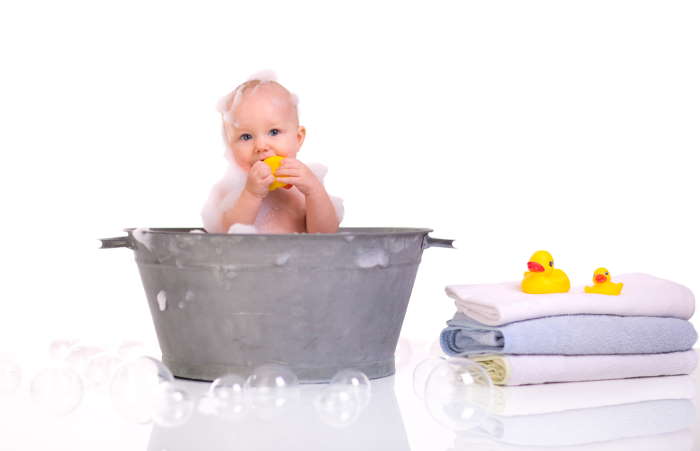
Table of Contents
A Baby Bath Time Routine
Are baths good for babies?
Regular bathing and general washing are obviously hygiene staples. Bathing your baby helps control the cradle cap, clean between folds, care for their delicate skin, and check for any abnormalities or rashes that might be developing.
A baby bath is also a bonding time and is important for emotional and sensory development. Scientists have referred to bathing as a “multi-sensory experience” for infants.
From simply feeling the water and your touch to listening to your speech, your baby is taking it all in and building neural connections. Additionally, bathtime is a routine event. Babies thrive on routines and they aid in their development.
Do baths relax babies?
In case you haven’t figured this out yet…babies are people. As tiny people, their likes and dislikes are individual. So, in theory, yes baby sponge baths relax little ones. If you’re lucky, the warm water, warm bath towel or warm washcloth, and cuddles might make them groggy for bedtime. Others, however, may detest sponge baths.
It might be the water depth, the temperature, or even the sound of the water running. If you find your little one doesn’t look like a giggly ad for baby wash during bathtime, it might be helpful to do some sleuthing and hunt down the culprit of their discomfort.
After some tweaks to your baby’s bath routine, even the most anti-bath baby might come to relax during the ritual.
How often should you bathe a baby?
As a newborn, there is absolutely no reason to give your baby a bath every single day. They don’t get as dirty as busy toddlers and their skin is so delicate at that stage. Excessive bathing can dry it out and lead to irritation. Until the umbilical cord falls off, pediatricians advise only giving your baby a sponge bath anyway.
At three months, your baby still only needs a bath one to two times a week. While there is no umbilical cord to complicate the routine, their skin is still delicate and prone to drying. If you’re diligent with wiping messes and diaper changes, they’re probably not getting too dirty either.
At 3-6 and 6-12 months, there’s no issue in bathing more than once or twice. However, it could be a good idea to only use soap once or twice a week. Excessive products still have a tendency to bother the baby’s scalp and skin.
With age, your baby might be getting messier from solid foods or just enjoy splashing in the water. In which case, it’s perfectly okay to do a quick wet washcloth wipe down/rinse several times a week and refrain from harsh soaps.
As you reach toddlerhood, the amount of bathing is more flexible. Toddlers usually enjoy bathing and the time can be relaxing for both of you. They are getting messier as they approach 1-2 years old…again, very messy. So, bathing more frequently is generally not an issue.
However, if your child is susceptible to eczema and skin irritation, it might still be a good idea to limit bathing to 2-3 times a week. Even if your toddler doesn’t suffer from itchy skin and maybe you are just swamped that day, skipping the bath is fine and washing every other day should suffice!
When should you bathe a baby?
If your baby is a fan of bathtime, bathing in the evening can be a relaxing cue for their upcoming bedtime. Have we mentioned babies like routine? Setting them up to get comfy and cozy is a tried and true method for encouraging sleep. And if you’re riding the struggle bus when bathing, try introducing some new toys or singing a new song.
However, if you‘re struggling in giving your baby’s first bath, it could be a good plan to shake up that schedule. You could try a morning or afternoon baby bath that flows into playtime or a feeding.
What temperature should a baby bath be?
When running your infant’s bathwater, you should aim for a temperature somewhere between 90-100℉. Safety experts also recommend setting your hot water tank at or below 120℉ to prevent unintentional scalding. There are plenty of good baby bath thermometers on the market these days.
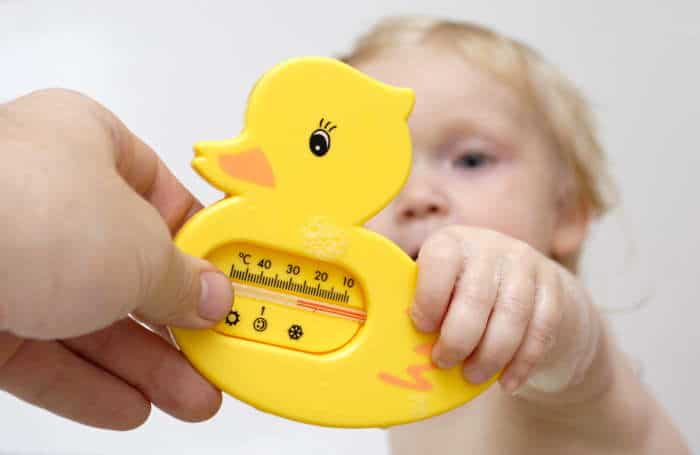
How to hold an infant in a bathtub
If you aren’t using a designated baby bath seat for a newborn (one that supports baby’s head and neck), it’s best to use one forearm to support their neck. Then, you can use your fingers to form a “C” under their shoulder/armpit. The secure grip will prevent accidental rolling in the water.
Always, always, always have a firm, safe hold on them while in the water. You can use your free hand to do all the washing and rinsing.
How long should your baby be in the bath?
Basically, a newborn baby should only be in the bath long enough to give him/her a good wash or wipe down. About 5-10 minutes should be sufficient. As your baby gets older and begins to enjoy bath time as a playtime event, you may find yourself extending the time in the bath a bit. The most important factor to remember is to never leave babies, no matter the age, in the water alone.
Can you bathe a baby in the sink?
A sink can work for bathing your baby and could be the simplest option for several weeks, especially if you’re waiting on the umbilical cord to fall off. Some infant tubs and supports are marketed specifically for sink bathing and the ability to wash while standing can save you the strain on your back.
Can I use my bath soap or do I need special baby soap and shampoo?
Baby wash or mild soap is advised for infants up to 12 months. Regular soap, or wash marketed for adults is severe and made to dissolve body oils that won’t be present on your infant’s skin.
You won’t even need to use soap at every wash and pediatric dermatologists recommend only using a cleanser on their bottoms and in the folds of skin. Of course, as they develop, washing is warranted as they begin to eat solid food and do more exploring.
How often should you wash baby towels?
Towels are basically Petri dishes hanging in your bathroom. We should all probably wash them more often and infant bath towels are not an exception. If you have dirty towels hanging up, chances are they’re home to a community of mold and yeast.
It’s wise to have at least three towels designated for your baby. Grab a clean one for each baby bath. Washcloths can be reused but still need to be swapped a couple of times a week.
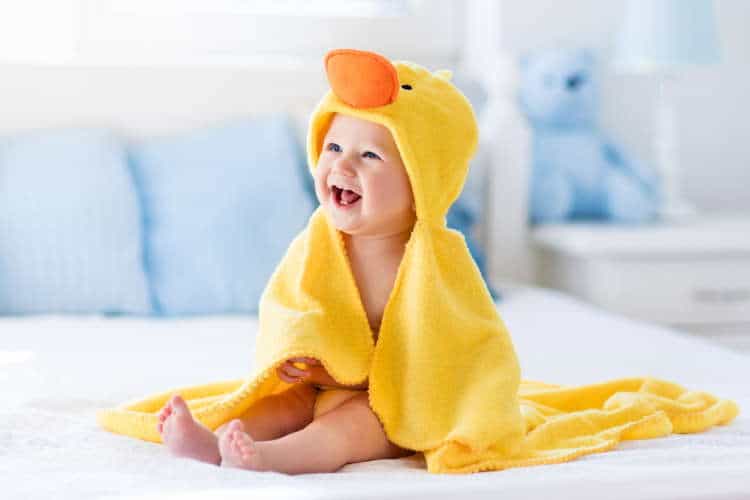
Bathtime Aids and Product Guide
There’s an entire corner of the baby gear market aimed at making baby bath time easier and stress-free. We’re breaking down the types of gadgets and their uses to make shopping easy.
Sink inserts
These are generally soft, moldable pieces of foam or sponge that sit down inside of your sink. They provide cushion and support to reduce the risk of slipping while you also support your baby with one hand.
Storage is simple. Just ring out the water and set out to dry. Some models are even washer/dryer safe to minimize the risk of mildew. Sink inserts can be excellent options for infants up to 6 months and they often make the transition to the bathtub with them.
Bathtubs
Baby bath tubs are essentially miniature tubs that can stand alone, go in the sink, or in the traditional bathtub. Some options are simple basins molded to support your infant, while others come with a convertible sling that transitions from newborn to older infant.
These can be great options for infants that cannot sit up yet as they are made to have them reclined during their baby bath. There are a number of different baby bathtub models on the market, but it’s important to find a tub with a sturdy base that isn’t prone to tipping.
Bath seats
Bath seats (like these) are marketed to assist babies that can already sit up (4-6 months). They’re supposed to provide support and stability but are in no way a substitute for supervision.
Although they may be helpful for especially busy babies, they aren’t deemed as necessary as other bathing options. The safety and reliability of their function have some experts divided on their place in the market.
Bath mats
If you’re looking for another option to curb slipping and sliding in the tub, a simple bath mat could be a sound option. They’re usually secured with suction cups or an anti-skid surface to keep in place and can make the hard surface of the tub more comfortable for your baby. We’ve rounded up a selection of some of the best baby bath mats for you here.
Thermometers
Tub thermometers are as diverse as the selection of bathtubs. Some are simple thermometers, while others can serve multiple functions such as bath toys, actual tubs, or spout covers.
The main benefit is making sure the water is at a safe and comfortable temperature for your baby.
Foam and Soaps
In the last few years, there’s been a growing awareness of what is in our products and how they may impact our children. The list of harmful ingredients that may be found in infant soap is long but the culprits include talc, formaldehyde, parabens, sodium lauryl sulfate, and heavy fragrances.
Luckily, as awareness of our products increases so do the number of safe washes on the market. Most infant soaps are designed for use on your baby’s body and hair. Aside from soap, a trusty moisturizer can be good for a bathing routine. Baby powder is no longer advised for infants.
Is PVC safe in baby bath toys?
PVC along with BPA and phthalates are not advised in baby bath toys or any other products. PVC is a known carcinogen while BPA and phthalates both interfere with hormone functions.
What age can a baby bathe without a seat?
Many babies are capable of making the switch to the bathtub at around 6 months. However, factors such as size and motor skills should be highly influential in your decision to transition them.
Even if they are comfortable sitting up in the tub, all safety precautions should be retained. Even one inch of water can be dangerous. Bath mats and sponges can still be helpful additions to bathing to minimize slipping and falling.
Safety Tips:
Running a bath
Always turn on your cold water first to minimize the risk of scalding. Setting your hot water tank’s temperature to 120℉ is also advised to prevent accidental scalding. Babies can and will grab the faucet at some point.
Checking Temperature
Use your elbow to check the water temperature. If it feels warm, not hot, then it is a safe temp for your baby. Our hands are tolerant of high heat while elbows are more sensitive and a better indicator of safe temperatures. Invest in a good baby bath thermometer.
Toys & Mold
Virtually all bath toys are susceptible to growing mold. Toys with tiny holes such as those that squirt water are especially prone to becoming moldy. Mold in bathwater has the potential to cause health concerns if the water is ingested or if your child has an allergy to mold or compromised immune system.
What to do when you find mold
If the toy is fairly cheap, it’s probably best to just toss it. Repeated exposure to mold is a cause for concern. If the toy was a bit of an investment, however, you have the option to clean it in a bleach/water mixture. White vinegar is also a decent cleaning agent if you’d like to avoid bleach.
When buying new bath toys, it’s a good idea to avoid toys with tiny holes that retain water. Try looking for toys with solid construction that allow complete drying.
Attention!
There are universal safety precautions that all parents and caregivers need to be mindful of
- Never leave your baby unattended. An infant can drown in only one inch of water.
- Use a smaller space such as the sink or specified baby tub to minimize risk of slipping, falling, or dropping
- Have all supplies within reach so you can support baby with one hand at all times
- Run cold water first and then add hot
- Silence cell phones to avoid unnecessary distractions
Surface Clean Only
Ears
It could be best to use a cotton ball or clean cotton cloth to clean ears. It’s not advised to stick q-tips or a soft washcloth into the ear canal for any reason. Earwax is healthy for ears and shoving foreign objects into the canal can cause damage. (Also, older infants might be tempted to put things in their ears if they see mom or dad doing it.)
Nose
For normal cleaning, it’s best to surface clean like you do for ears and refrain from putting anything in the nasal passage. Unless the baby is having trouble breathing, boogers are probably best to be left alone. Newborns often sound stuffy, but these are generally normal noises for them when tired.
Bulb Syringe vs. NoseFrida
If your infant comes down with a stuffy nose from a cold, you have the option to use a bulb syringe to suction the mucus. This is done by placing the tip of the squeezed bulb into nostril and releasing. For thick mucus, a saline drop solution can be used to thin it before suctioning.
Another option on the market is the NoseFrida. Powered by your mouth, you simply place the tip in the nostril and suck from the other end. Often, it’s often more effective in releasing mucus and you have the ability to thoroughly clean the tube. It’s clear, which also eases your mind about the development of mold.
The drawback of the NoseFrida being the sponge filter that mitigates the suction of your little one’s snot into your mouth, won’t prevent viral transfer.
Bathtime Routines
Bath time routines are helpful for you, as the parent, but also for babies. They thrive on routine and knowing what to expect and when can reduce fussiness and stress. Bath time is also convenient for other hygiene measures such as nail clipping. Their tiny talons are softer after coming out of the water and easier for clippers to snip.
Bath time is also a time to look over their skin. It’s a good idea to check for new rashes or abnormalities to make note of. If they suffer from cradle cap, you can use a soft brush designed specifically for breaking up the build up.
Making a bath part of your bedtime routine can be helpful in transitioning them into the quieter part of your day. Using your favorite lotion afterwards and reading a book afterwards can help relax them as well.
As your infant grows, consider adding teeth brushing while in the bath. They can try it in the rub and you won’t have as much mess. Usually, brushing teeth is recommended as soon as they appear. By 6 months, you’ll probably want to get started. Newer dental guidelines suggest using a low fluoride toothpaste even with infants.
What do you do when your baby doesn’t like bath time?
If your baby isn’t fond of the splish splash, you could try double-checking the room. Is the water too cold or hot? Is there a draft? Are they scared of the harsh bright lights in the bathroom?
If they’re cold try wrapping the body parts you aren’t washing in a warm towel or simply drape a warm washcloth over their body. Another option is co-bathing! Safety precautions still apply and you have to mind having a firm grip on your baby, but this is an opportunity for bonding. Having you close may ease your baby’s stress and skin to skin contact is an added benefit.
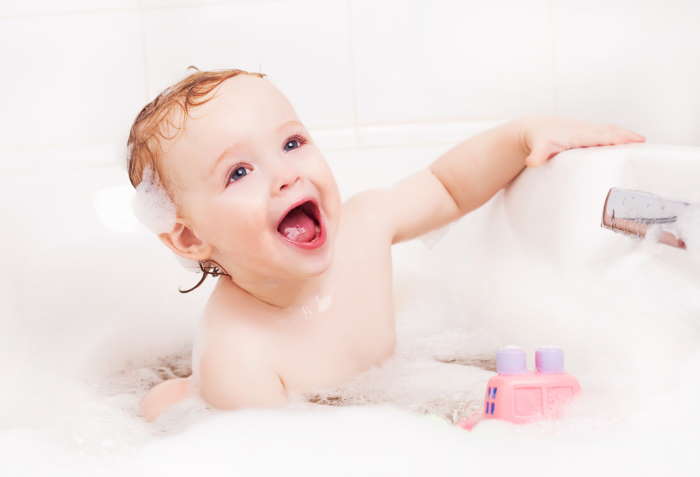
Making it fun
If your baby still isn’t loving it, try singing or added baby talk. If they’re a little older new bath toys could entice them into enjoying it a bit more.
There’s a whole list of bath accessories that include bath markers, chalk, waterproof books, fun spout covers. Sometimes, getting a little goofy is all it takes to induce a smile and a giggle. If you’re engaging with your baby and showing them the fun appeal of the toys, chances are they’ll get it and want to play along.
Bath time can be ideal to introduce new motor skills and cause/effect development through play!


